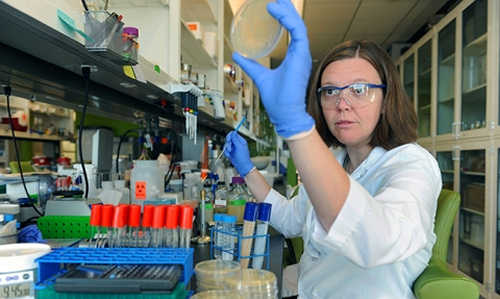Most people have taken an antibiotic to treat a bacterial infection. Now researchers from the University of North Carolina at Chapel Hill and the University of San Diego, La Jolla, reveal that the way we often think about antibiotics – as straightforward killing machines – needs to be revised.
The work, led by Elizabeth Shank, an assistant professor of biology in the UNC-Chapel Hill College of Arts and Sciences as well as microbiology and immunology in the UNC-Chapel Hill School of Medicine, and Rachel Bleich, a graduate student in the UNC-Chapel Hill Eshelman School of Pharmacy, not only adds a new dimension to how we treat infections, but also might change our understanding of why bacteria produce antibiotics in the first place.
“For a long time we’ve thought that bacteria make antibiotics for the same reasons that we love them – because they kill other bacteria,” said Shank, whose work appears in the February 23 Early Edition of the Proceedings of the National Academy of Sciences. “However, we’ve also known that antibiotics can sometimes have pesky side-effects, like stimulating biofilm formation.”
Elizabeth Shank, an assistant professor of biology in the UNC-Chapel Hill College of Arts and Sciences
Shank and her team now show that this side-effect – the production of biofilms – is not a side-effect after all, suggesting that bacteria may have evolved to produce antibiotics in order to produce biofilms and not only for their killing abilities.
Biofilms are communities of bacteria that form on surfaces, a phenomenon dentists usually refer to as plaque. Biofilms are everywhere. In many cases, biofilms can be beneficial, such as when they protect plant roots from pathogens. But they can also harm, for instance when they form on medical catheters or feeding tubes in patients, causing disease.
“It was never that surprising that many bacteria form biofilms in response to antibiotics: it helps them survive an attack. But it’s always been thought that this was a general stress response, a kind of non-specific side-effect of antibiotics. Our findings indicate that this isn’t true. We’ve discovered an antibiotic that very specifically activates biofilm formation, and does so in a way that has nothing to do with its ability to kill.”
Shank and her team previously reported that the soil bacterium Bacillus cereus could stimulate the bacterium Bacillus subtilis to form a biofilm in response to an unknown secreted signal. B. subtilis is found in soil and the gastrointestinal tract of humans.
Using imaging mass spectrometry, they subsequently identified the signaling compound that induced biofilm production as thiocillin, a member of a class of antibiotics called thiazolyl peptide antibiotics, which are produced by a range of bacteria.
At that point, Shank and her colleagues knew thiocillin had two very specific and different functions, but they didn’t know why – and wanted to know how it worked. That’s when they modified thiocillin’s structure in a way that eliminated thiocillin’s antibiotic activity, but did not halt biofilm production.
“That suggests that antibiotics can independently and simultaneously induce potentially dangerous biofilm formation in other bacteria and that these activities may be acting through specific signaling pathways,” said Shank. “It has generated further discussion about the evolution of antibiotic activity, and the fact that some antibiotics being used therapeutically may induce biofilm formation in a strong and specific way, which has broad implications for human health.”
Story Source:
The above story is based on materials provided by University of North Carolina at Chapel Hill.





